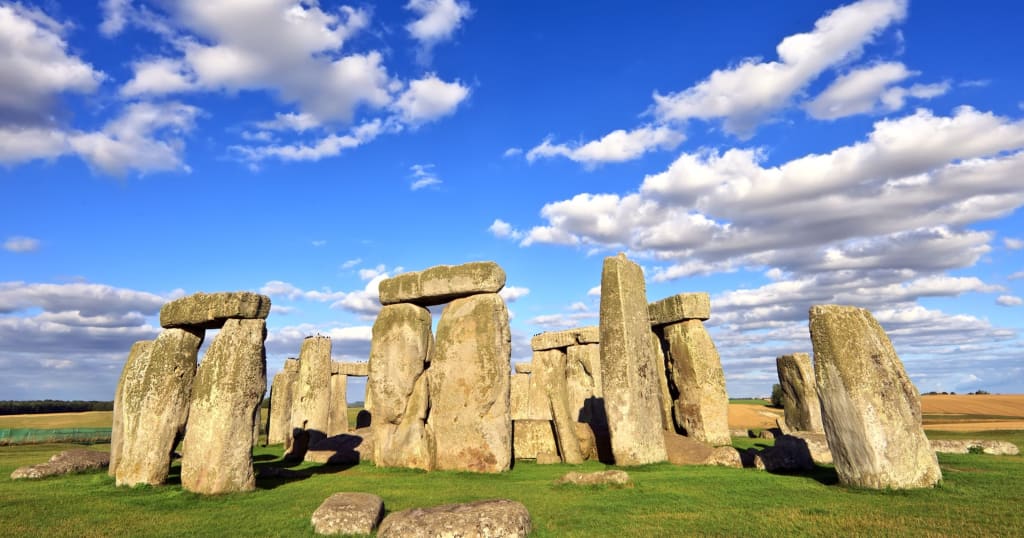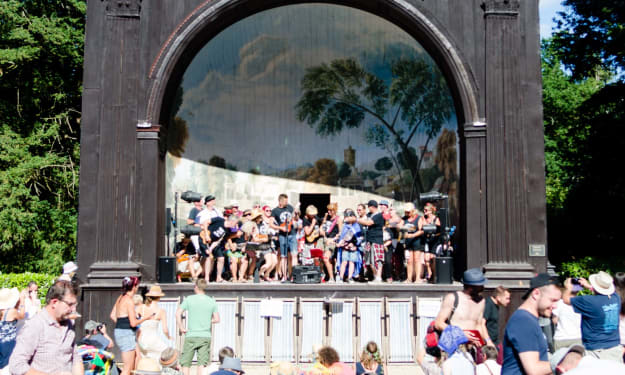Believe it or not?
The ley line theory of magical lines that crisscross the world between centres of ancient earth energies.

Believe it or not? The ley line theory of magical lines that crisscross the world between centres of ancient earth energies.
Welcome to the world of earth energies, ancient and Christian spiritual sites, Roman roads, Arthurian Legend, dragons, angels and power, all wrapped up in a theory of astronomical alignments and spirituality that has long since been forgotten and is no longer felt or understood by the modern inhabitants of the United Kingdom.
The ley line theory was first developed in 1921 and since then there has been a debate about whether they exist or not and if they do exist then what purpose they serve? In 1921 an amateur English archaeologist Albert Watkins noticed that ancient sites at all points around the world fall into a sort of alignment, whether they are man-made or natural. He called these leys and in doing so he opened a world of supernatural and spiritual beliefs. To those who choose to believe in them the concept is simple, they are lines that crisscross around the globe between ancient monuments and natural landforms, carrying supernatural energy, like an electricity line. Where the lines intersect there is concentrated energy that can be harnessed by certain individuals and were very real and important to our ancient ancestors, who were much closer to nature and mother earth than we are today. Along these ley lines lie Stonehenge and Avebury Ring and the Great Pyramids of Giza in Egypt and Chichen Itza in Mexico.
There are many leys lines connecting the abundance of Neolithic, Bronze and Iron Age sites in the English counties of Wiltshire and Dorset. The entrance to the West Country where the busy South East becomes a rural idyll of fields, farms, hills, valleys and woodland, rich in history from ancient times, through the middle ages to the Victorian era. In this area the main lay lines run through Stonehenge, Old Sarum, Salisbury Cathedral and Clearbury ring. The energy is centered at Stonehenge and ley hunters say that the energy can be detected again at Old Sarum and in the Cathedral close of Salisbury Cathedral. Such locations are said to act as a focus for these powerful earth energies, something that our ancient ancestors knew a great deal about, but we know very little.
• There are other ley lines on the Dorset side which run between: Knowlton; a Neolithic henge complex, Bronze age barrows and Norman Church)
• Badbury Rings; a hillfort west of Wimborne
• The Cerne Abbas Giant, the famous chalk figure cut into the hillside just north of Dorchester
• Hellstone, a Neolithic Dolmen complex with the roof and chamber intact, also near Dorchester, the entrance of the which is aligned with the Winter Equinox sunrise
• Nine Stones, a Bronze age stone circle at Winterbourne Abbas and a powerful site for earth energies
• Kingston Russell (another bronze age stone circle just north of Abbotsbury, with astronomical alignments and dowse-able energies
• Bronze age Rempstone just north of Corfe Castle
• Verwood Megalith, Dorset’s largest remaining megalith stone),
• Helstone, the tallest standing megalith in Dorset which is aligned astronomically with nearby barrows,
• Corscombe, a Neolithic chambered tomb with outlying stones and finally
• Maiden Castle near Dorchester, Europe’s largest Hillfort. A massive Neolithic and Bronze age site with burial barrows and a Roman Temple.
It seems that all ancient peoples in this region of England knew the significance of the energies at this site which radiate out from and too these ancient sites.
The grand sarsen stones of Stonehenge in Wiltshire near Salisbury are the center of it all and this is a world heritage site attracting millions of visitors from all over the world. There are 15 number, 7-meter-tall stones, each weighing about 20 to 25 tons. They make up the central horseshoe and the uprights and lintels of the outer circle. There are also outlying stones. Constructed between 4000 and 5000 years ago over several centuries, the builders of Stonehenge sourced the stones from quarries by nearby Marlborough. It is regarded as a British cultural icon and is owned by The Crown and managed by English Heritage and the National Trust. The land on which Stonehenge sits was a burial ground when the ditch and bank were first dug 5000 years ago. Construction then continued for another 500 years culminating in the hauling of the stones across the landscape 18 miles across the Marlborough Downs (using a wheel and pulley system or a type of sleigh greased with animal fat and pulled by over 100 men) and construction of the stone circle. The heel stone and the embedded avenue is aligned to the sunset of the winter solstice and the sunrise of the summer solstice. It is thought that for 3000 years it was used as a burial site, ceremonial site, religious pilgrimage destination, final resting place for Royalty and a memorial to spiritually connect with distant ancestors.
There are even ley lines in London, the Capital of the United Kingdom 90 miles east of Stonehenge and now a megacity of 9.3 million people with people from over 270 countries living there and over 300 different languages spoken. The discovery earlier this year of a ceremonial place of assembly from the fourth millennium BC suggests that London was a center of organized social and political activity 3000 years earlier than was first thought and not an Iron Age village founded by the river Thames as previously thought. This may explain why Greater London is so rich in Ley Lines connecting key historical sites. To the believer these lines are in triangles and straight alignments, forming an ancient, sacred landscape.
A triangle of ley lines connects The Naval College in Greenwich on the River Thames with Caesar’s Well on Wimbledon Common and Boudicca’s mound on Hampstead Heath. The center of this triangle is Tothill Mound (an ancient burial mound). Ley hunters say that this shows the significance of sites of earth energies to the Ancient Britons, of which Boudicca, the Warrior Queen of the British Celtic Icini Tribe who led an uprising against the conquering army of the Roman Empire in AD60, was the most famous leader. It also connects the Romans who founded Londinium shortly after the invasion and occupation of Britain in AD43 by the Emperor Claudius to AD410, when the Emperor Honorius sent a goodbye letter to the people of Britain, writing “fight bravely and defend your lives, you are on your own now”. The city of Rome was falling apart and under attack so the Romans had to leave to take care of matters back home. Caesar’s well was named after the most famous Roman Emperor Julius Caesar (100bc to 44bc) .
A second triangle has been dowsed which connects Boudicca’s mound with The Tower of London (the mediaeval fortress and prison where important political and royal prisoners spent their final days either locked up or awaiting execution) and West Brompton Cemetery. This alignment was used by John Nash when he designed the long ceremonial avenue in London’s Regent’s Park in London. Major architects and town planners seemed to understand and utilize these earth energy alignment lines right up to the 18th Century in England. So, when did we lose our connection with the Earth? I suggest that it was during the Industrial Revolution and into the modern era when we became more interested in making money to be in touch with our ancient ancestral past.
Dosing is the practice of using a forked piece of hazel, rowan or willow wood, a Y shaped pendulum on a thread or two metal rods on handles that allow them to spin freely, to locate water, minerals, archaeological remains, treasure and magnetic earth energies. The technique is associated with Occult practices, but this is frowned upon by dowsers. In its truest form, used by ley hunters, the dowser simply grasps the rod by its two prongs and receives transmissions from the earth energies or hidden objects which cause an involuntary muscular contraction which makes the rod bend or quiver violently, or the modern metal dowsing rods to spin. It may be that dowsing picks up on magnetic earth energy or magnetism from metal and water. It is, like ley lines, loved and believed by the enthusiasts and mocked and disregarded my many.
There are two major ley lines (alignments) in England which have been postulated. One is Saint Micheal’s line that runs from Land End in the extreme West of England (at the very end of Cornwall), to Hopton on Sea in Essex. Along the way it connects many sites that are devoted to St Michael (such as St Micheal’s mount in Cornwall) and due to its orientation, the direction of sunrise on May 8th when the Catholic Church celebrates the Apparition of St Michael. In his book “The View over Atlantis” published in 1969, John Mitchell describes the line as
“The St Michael line of traditional dragon sites in South West England is remarkable for its length and accuracy. It appears to be set between two prominent Somerset hills both dedicated to St Michael with ruined churches on their summits. These two hills are Glastonbury Tor and “The Mump” at Burrowbridge. Both of these hills appear to have been artificially shaped so that their axis align with each other”
So, this 350 mile line connects monasteries dedicated to the Archangel Michael to the legendary Kingdom of Avalon, home of King Arthur and …Beyond that it connects with Mont St Michel in Brittany, France and monasteries in the middle East, so it could be the most powerful and significant ley line in the world
The major theoretical ley line running through London is The Canterbury Line, which runs through the City of London and connects Canterbury Cathedral in the east to the Cisterian Monastry site of Abbey Dore in the West connecting (East to West) Rochester Cathedral, Greenwich, Downing Street and Gloucester Cathedral on the way through. There is a Roman road along much of this alignment which suggests that the Romans may also have been in tune with the earth energies too, as well as the ancient indigenous people. The connection of Downing Street is an interesting addition as this is the Residence and Office of the Prime Minister of the UK at Number 10 Downing Street and the Chancellor of the Exchequer (the Treasury) at Number 11. A connection of the Spiritual with the modern seats of Power and Political center stage.
As previously mentioned, ley line believers and theorists believe that they crisscross the world connecting centers of earth energy such as Chichen Itza (the ancient Mayan Temple on Yutacan Mexico) and the ancient Inca city of Machu Piccu in Peru. The common theme is ancient history and spirituality, a connection with the earth that we have lost, so we may never know the truth now.
John Vallis December 2020
About the Creator
John Vallis
Dad, uncle, Traveller, guitarist, academic, conservationist, environmentalist and wastewater engineer by trade.
Enjoyed the story? Support the Creator.
Subscribe for free to receive all their stories in your feed. You could also pledge your support or give them a one-off tip, letting them know you appreciate their work.






Comments
There are no comments for this story
Be the first to respond and start the conversation.